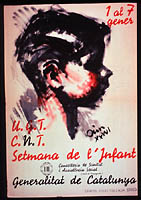 |
1 al 7 gener, U.G.T., C.N.T., Setmana de l'Infant
[January 1-7, U.G.T., C.N.T., Week of the Child]. Signed: Sim, XXXVI. Conselleria de Sanitat i Assistäncia Social. Seccio de Propaganda. Generalitat de Catalunya. Grafos Colectivizada Barna. Lithograph, 2 colors; 50 x 35 cm.
|
|
This small poster, issued
by the Generalitat, the government of Catalonia, it announces, in
Catalan, the "Week of the Child." The image includes the
initials of the two largest trade unions in Spain before and during
the war, the socialist-revolutionary Unión General de
Trabajadores (UGT), and the Anarcho-syndicalist Confederación
Nacional de Trabajadores (CNT). The joint presence of the initials
of the UGT and the CNT reflects one of the many alliances that took
place among trade unions and political organizations during the
war period in Republican Spain. The CNT led the resistance to the
military rebellion of July 1936 in Catalonia; as a result, the anarchist
union was the de facto power in the region during the following
months. On December 17, 1936, representatives of the UGT entered
the Generalitat, joining members of the CNT and of other
parties. It is probably this moment when the two trade-unions collaborated
in the government of Catalonia that is reflected in this poster.
The Week of the Child
was a festivity introduced in Republican Spain in the first week
of January 1937 and repeated throughout the country the following
year. The purpose of the event was to make the children forget the
horrors of the war by providing them with gifts. The Week of the
Child coincided with the feast of the Epiphany (the popular Reyes
Magos) which was observed on January 6, and had traditionally been
the moment when Spanish children received their Christmas gifts.
The Epiphany had ceased to be celebrated in much of Republican Spain,
together with all other public religious ceremonies, as a result
of the efforts to create a secular society. But it needed to be
replaced by a some festivity, in order to avoid any thought that
the traditional past had been better than the present. An article
in a contemporary newspaper referred to the Week of the Child in
1937, quoting a poster designed for the occasion: "The war
should not destroy childhood happiness. Toys and storybooks are
as necessary to children as bread. Children who play and read forget
the horrors of the war." The date that appears by the signature,
1936, suggests that the poster was designed in that year, and used
to advertise the subsequent Setmana de l'Infant of January 1-7,
1937.
This poster bears the
signature "Sim," a pseudonym used by the painter Rey Vila.
He received his artistic training in the Escuela de Bellas Artes
in Barcelona. An unsigned text in an album of images which he executed
during the war (12 Escenas de Guerra) states that during his military
service in the Spanish territories in northern Africa, which coincided
with the defeat of the Spanish troops at Annual (July 21, 1921),
Sim "became aware of the moral turpitude of politicians and
of the military, and he became a firm defender of the people.
For that reason, his
drawings have an improvisational character, agile and nervous, emotional
and revolutionary." In the first months of the war, Sim arrived
at the headquarters of the artists' trade-union in Catalonia, the
Sindicat de Dibuixants Professionals, "with an album
of drawings under his arm" which he offered for publication
(this album is probably Estampas de la Revolución Espa§ola,
19 de Julio de 1936). Sim was refused, partly because drawings were
not seen as adequate means of propaganda, and also because he lacked
personal references, an important liability in a climate of intense
suspicion caused by the war. This poster is evidence that Sim found
other means to collaborate with the war effort, working for the
Generalitat (publisher of this poster), and also for anarchist organizations
(the aforementioned album Estampas de la Revolución Española
was published by the Spanish Anarchist Party, FAI, and by the CNT).
After the war, Sim was exiled to Paris, where he continued working
as an artist, signing with his own name, Rey Vila.
|




